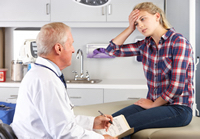
By David Bertone, PT, DPT, OCS
The incidence of concussion in youth sports continues to rise, and parents are often left with trying to navigate the process on their own. According to the Centers for Disease Control and Prevention, there are between 1.6 and 3.8 million sports-related concussions in the United States every year. In addition, a 2012 study that analyzed 20 high school sports found that concussions accounted for 13 percent of all injuries reported with two-thirds occurring during competition and one-third in practice. The highest incidence rates occur in football, boys’ ice hockey, girls’ soccer and boys’ lacrosse. The diagnosis of concussion is fairly easy to make. If your child hits their head and has symptoms that develop, they are likely concussed and must be immediately removed from sports.
Unfortunately, most parents get their first piece of education about the concussion process in the local emergency room, which is not always the best place to go following a mild head injury. The ER is often loud, bright and hectic, which is over stimulating to the concussed athlete and can make the symptoms of headache, dizziness and irritability even worse. But the ER gives parents the much-needed piece of mind that nothing “serious” is going on and they are placed at ease. CT scans are rarely performed because of the unnecessary radiation exposure. There are, however, several red flag signs that require an immediate visit to the local emergency room. They are headaches that worsen, seizures, slurred speech, repeated vomiting, weakness or numbness in legs or arms, unable to recognize people or places, worsening confusion or irritability, severe neck pain and difficulty awakening your child.
In the far majority of situations after a mild head injury or concussion, initial physical and cognitive rest is the most important treatment. This allows the brain to heal during a vulnerable time. The key concept when your child is resting is to allow them to sleep and avoid any stimulating activities such as reading, television, video games, computer tasks and exercise. It is also important to not wake your child while they are sleeping, but instead check for normal breathing to confirm they are not in any distress. Sleep is good and will improve healing.
The 2023 consensus statement of concussion experts that met in Amsterdam now recommends the following steps following a sports related concussion: Up to 48 hours of relative rest with activities of daily living and reduced screen time. Light physical activity should then be encouraged like walking or stationary cycling that does not more than mildly exacerbate symptoms.
A visit to the pediatrician is often the next step. However, the pediatrician does not always have objective testing available to make a decision on readiness for return to school or safe return to sports. This is where a health care practitioner that is involved in all aspects of concussion management is important. A physical therapist with extensive experience in this area can improve the process of return to play by objectively measuring your child’s balance, neurocognitive function, as well as eye movement speed and processing. These are important factors that are compared to preseason baseline testing values, or in the case when no baseline testing is available, compared to normative data. This information is forwarded to your pediatrician with recommendations based on the results. If deficits exist in any of the areas, quite often a short course of rehabilitation is recommended by a physical therapist specifically trained in concussion management.
In order to have an objective picture of your child’s brain function before a head injury occurs, comprehensive baseline testing is recommended. This should be done before the sports season begins and should include neurocognitive, oculomotor and computerized balance testing. This data will then be used for comparison if and when a head injury occurs.
Dr. Bertone is a Doctor of Physical Therapy and board certified orthopedic clinical specialist by the American Board of Physical Therapy Specialties with over 35 years of clinical experience. He is the owner of db OrthoPT with locations in Red Bank and Manalapan. He can be reached at dborthopt.com.
The article originally appeared in the August 3 – 10, 2023 print edition of The Two River Times.














